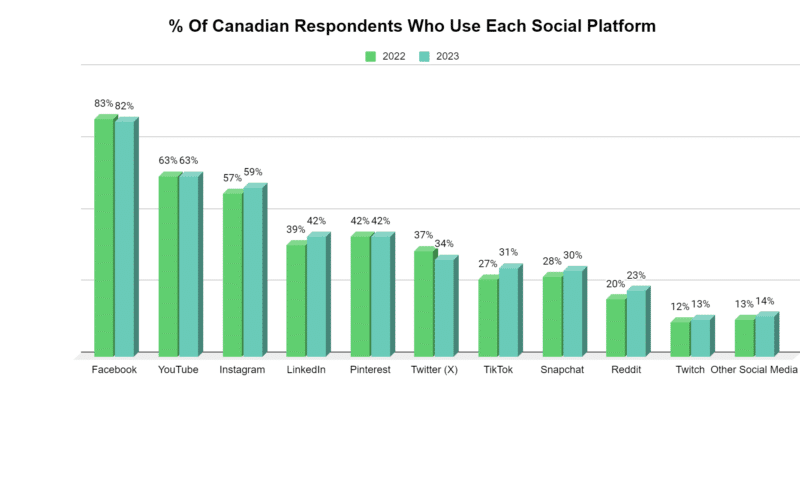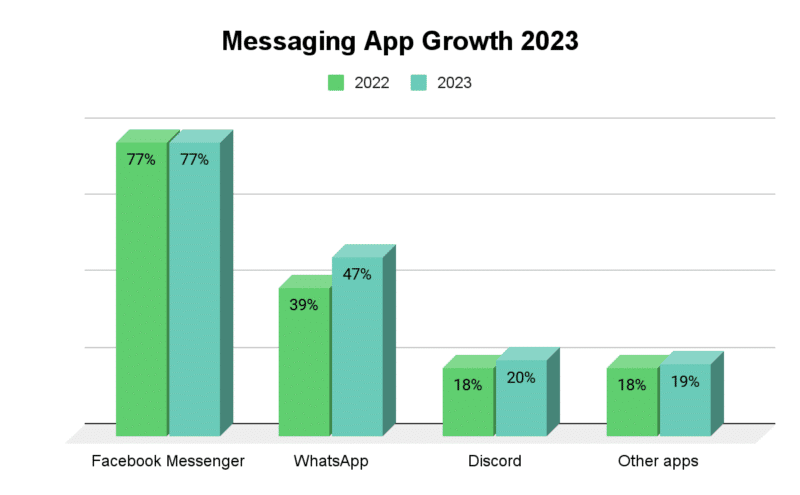2023 saw many changes to the social media landscape. Twitter rebranded itself as X, while Meta introduced Threads, setting a record as the fastest-growing app of all time, with 100 million users joining in just five days. As social media platforms evolve, so do Canadians’ ways of using them.
Leger DGTL recently conducted a comprehensive study (which can be found here) surveying 3,046 Canadian respondents to discover their social media usage changes in 2023. Below, we’ll explore this report and discuss the most significant changes to Canadian social media habits you should know about as we head into 2024.
Where is Everyone?

(Source, Leger DGTL)
Facebook is still the most used platform in Canada, with YouTube, Instagram, and LinkedIn still being quite popular. LinkedIn and TikTok saw the most considerable growth, while X, formerly Twitter, saw the most significant user decline. Facebook users in Canada also saw a decrease, which could be in part because of the removal of news on the platform. Canadians’ platforms of choice change as the platforms themselves evolve.
X Doesn’t Mark the Spot: A Challenging Year for Former Twitter

X faced quite a challenging year in 2023 as rivals like Bluesky and Mastodon continued to grow. Meta’s Threads launched to record-breaking numbers, which also contributed to the flooding of the market with X alternatives. Adding to the difficulties, X experienced a significant loss of advertisers following allegations of rampant antisemitism on the platform. Major advertisers, such as Disney, Apple, and IBM, all ceased advertising on X. This exodus isn’t limited to advertisers alone, as the Leger DGTL study reveals that 26 per cent of Canadians who abandoned a social media platform in 2023 cited “toxic content” as their reason for leaving. This could be a significant factor in why Canadians are abandoning X.
Messaging is Growing Fast

(Source, Leger DGTL)
The Leger DGTL study shows that WhatsApp grew exponentially in the Canadian marketplace last year. In 2023, 47 per cent of respondents had a WhatsApp account, compared to 39 per cent in 2022. Integrating WhatsApp into your Facebook page may be a good idea if you wish to engage with this growing user-base.
TikTok Isn’t Just a Trend
Leger DGTL also divulges that TikTok has caught on with millennials (aged 25-44), as 45 per cent of respondents in this age bracket said they had an account. TikTok is still most popular with Gen Z (aged 16-24), as 60 per cent of them stated they had an account. Additionally, 33 per cent of this demographic mentioned using the app at least once a day. TikTok has started experimenting with static content and now has a photo mode, similar to Instagram, where users can post static content. Watching TikTok’s growth in 2024 will be interesting, especially if it implements features commonly found on other platforms.
@caitlinjenco Tiktok now has photo mode where you can post static photos to your page! You have the option to upload multiples as a carosel as well! What do you think about this? #tiktokupdate #newtiktokfeature #tiktokstrategist #tiktokgrowthcoach #contentcreatorcoach #caitlinjenco #greenscreen #greenscreenvideo
Is Meta’s Threads Unravelling?

While Threads experienced record-breaking growth when it entered the social media scene, it appears the hype may have been short-lived. The Leger study reveals that while 11 per cent of respondents stated they had a Threads account, only six per cent said they used the app at least once a week, while only four per cent said they used it once a day. Threads’s daily active users dropped significantly, from about 40 million to just 23.6 million after its first week. However, this was only Threads’s first year on the market. As Meta continues to add more demanded features, such as an API, direct message functionality, and hashtags to categorize content, the number of daily active users could see healthy growth, especially as users continue to flee X.
Digital Wellbeing and Mindful Consumption

The Leger DGTL study revealed that 23 percent of respondents identified the internet as a source of stress, marking an increase from 21 percent in 2022. Recognizing the need for balance, 15 percent of Canadians implemented mechanisms to limit their time on social media apps, reflecting a growing trend towards digital wellbeing and mindful consumption. As we head into 2024, we must be aware of the digital burnout many of our targeted audiences may be experiencing.
Changes for 2024

As we begin 2024, keeping an eye on the trends in Canadian social media habits is essential. The struggles of X, the surges in WhatsApp popularity, the steady growth of TikTok and the emphasis on digital wellbeing underscore the evolving nature of social media engagement in Canada. Navigating the changing social media landscape requires a strategic approach that adapts to current trends and stays alert to the preferences of Canadian social media users.
If you need help with the evolving social media landscape, contact us today, and see how we can help you with your social media strategy!





